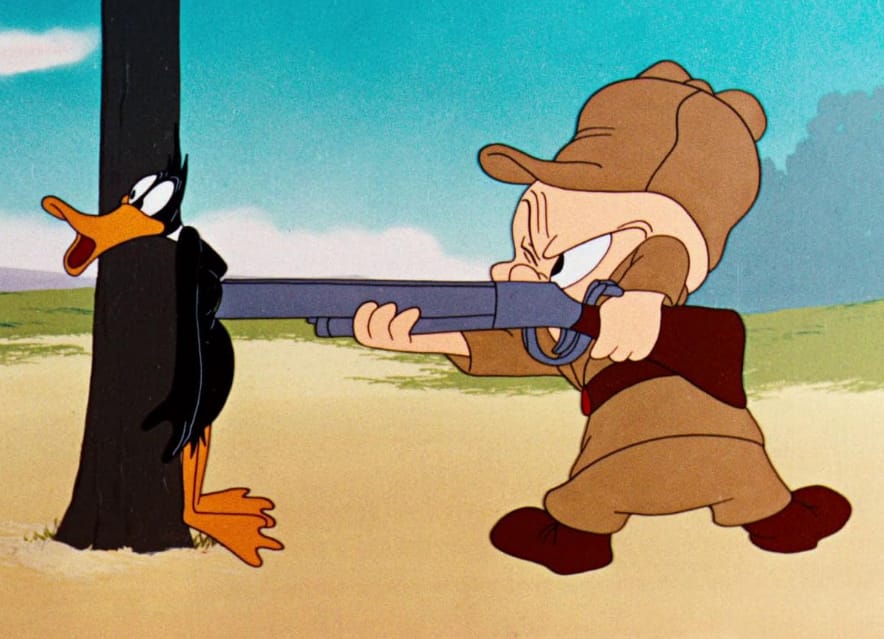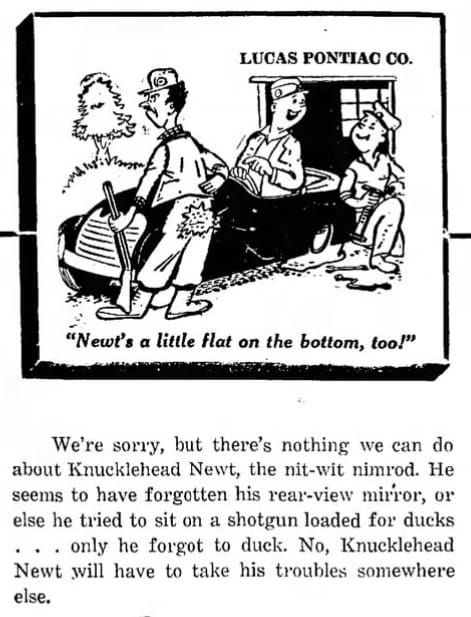nimrod

In current usage, nimrod is often used as a disparaging term for an inept or foolish person. This usage is often said to come from young viewers misinterpreting a 1940s Bugs Bunny cartoon, but that is not quite true. A Warner Brothers cartoon does play a role in the word’s history, but it’s not Bugs Bunny, but rather Daffy Duck, who utters the word. And Daffy’s use of the word was in an already established sense that connoted an inexperienced hunter.
The name Nimrod is biblical. Nimrod was a great-grandson of Noah. The name is probably a variant of Ninurta, a Mesopotamian god of war and the hunt. He appears in Genesis 10, with early English translations spelling his name as Nenroth, Nemroth, and similar variations. From the Old English translation of Genesis:
An þære wæs Nenroth; þe Nemroth wæs mihtig on eorþan. & strang hunta ætforan Gode. Be þam wæs gecweden bigword, swa swa Nemroth strang hunta ætforan Gode. His rices angin wæs Babilon & Arah, & archat & Cahanne on þam lande Sennar. Of þam [l]ande ferde Asur, & getimbrode þa buruh Niniuen, & burhga streta. Oþre burh he getimbrode eac, þe hatte Chale. Oþre burh he getimbrode eac, þe hatte Chale. The þriddan burh þe he arærde het Reson, betwux Niniuen & Cale; þeos is micel burh
(Another [son of Cush] was Nimrod; this Nimord was mighty on earth and a powerful hunter before God. A proverb was said about him, just as Nimrod a powerful hunter before God. His kingdomes were Babylon and Uruk, and Akkad and Kalneh in the land of Shinar. From that land he went to Assyria, & built the city of Ninevah, & the streets of that city. He built another city also, which is named Calah. The third city that he erected is named Resen, between Ninevah and Calah; this is a great city.)
In folklore, Nimrod is often associated with the Tower of Babel, often depicted as the king who ordered it constructed. But this association has no biblical basis. The Middle English poem The Story of Genesis and Exodus, probably composed in the mid thirteenth century and with a manuscript witness penned sometime before 1325 depicts him as a conqueror who seized the land where the tower had stood:
Babel, ðat tur, bi-lef un-mad,
ðat folc is wide on lon[de] sad;
Nembrot nam wið strengðhe ðat lond,
And helde ðe tur o babel in his hond.
(Babel, that tower, remained unmade,
That folk were widely throughout the land scattered;
Nimrod took with force that land,
And held the tower of Babel in his hand.)
Geoffrey Chaucer makes mention of him in his poem The Former Age. That poem ends with this stanza, depicting Nimrod as a conqueror who built “towers high” and symbolic of the evil that had befallen the world:
Yit was not Jupiter the likerous,
That first was fader of delicacye,
Come in this world; ne Nebrot, desirous
To regne, had nat maad his toures hye.
Allas, allas, now may men wepe and crye!
For in oure dayes nis but covetyse,
Doublenesse, and tresoun, and envye,
Poyson, manslawhtre, and mordre in sondry wyse.
(Jupiter, the lecherous, that first was the father of wantonness, had not yet come into this world; nor had Nimrod, desirous to reign, made his towers high. Alas, alas, now may men weep and cry! For in our days there is nothing but greed, deceitfulness, and treason, and envy, poison, manslaughter, and many ways to murder.)
And in early use, the idea of Nimrod as a conquering tyrant was the dominant one. Here’s another example, this one from John Bale’s c.1548 The Image of Bothe Churches, in which Nimrod is used as a general epithet for a tyrant, in this case the ruler of Sodom:
The boystuouse tyrauntes of Sodoma wyth their great Nemroth Winchester, and the execrable cyteʒe[n]s of Gomorra w[ith] their shorne smered captaines, wyll sturre abought them.
(The boisterous tyrants of Sodom with their great Nimrod Winchester, and the execrable citizens of Gomorrah with their shorn, smeared captains, will stir about them.)
But early in the next century, nimrod starts to be used as a metaphor for a hunter, recalling his description in Genesis. From a 1623 poem by William Drummond:
This World a Hunting is,
The Prey poore Man, the Nimrod fierce is Death,
His speedie Grayhounds are,
Lust, Sicknesse, Enuie, Care,
Strife that neere falles amisse,
With all those ills which haunt vs while wee breath.
And as we move into the modern era, the hunter sense becomes the dominant one. But it also starts to be used ironically. Instead of a “mighty hunter,” a nimrod becomes an inexperienced or foolish one. For example, Washington Irving writes in his 1835 A Tour on the Prairies:
I have observed that the wary and experienced huntsman and traveller of the prairies is always sparing of his horse, when on a journey; never, except in emergency, putting him off a walk. The regular journeyings of frontier-men and Indians, when on a long march, seldom exceed above fifteen miles a day, and are often about ten or twelve; and they never indulge in capricious galloping or curvetting. With us, however, many of the party were young and inexperienced, and full of excitement at finding themselves in a country abounding with game. It was impossible to retain them in the sobriety of a march, or to keep them to the line. As we broke our way through the coverts and ravines, and the deer started up and scampered off to the right and left, the rifle-balls would whiz after them, and our young Nimrods dash off in pursuit.
Ben Hecht’s and Gene Fowler’s 1933 play The Great Magoo uses nimrod to refer to a man who relentlessly pursues women, a hunter of a different type. This particular nimrod, while perhaps not foolish, is not portrayed in a favorable light. The following exchange is between an older woman and a younger one who has fallen for an unfaithful lover:
TANTE: Now, dearie, I wouldn’t let anybody else in the world say one word against him, but I’m beginning to get disillusioned. He’s got a dame now….
JULIE: Please don’t tell me.
TANTE: Might as well know the truth, and not make a monkey of yourself. She’s an equestrienne. A fine little piece, and he’s in love with her. That makes about the tenth. The same old Nimrod. Won’t let her alone for a second. Jealous of her horse, even. But he claims it’s forever this time. It’s disgusting. It’ll wind up just the same, with this poor little circus artist crying her heart out, just like you—and Nicky hop-scotching after some new victim.

And in the 1940s, we start seeing the phrase nitwit nimrod used to refer to inept hunters. Here is one from an advertisement for a car dealership that appears in Greenville, Pennsylvania’s Record-Argus on 17 November 1948, around the same time as the Daffy Duck cartoon:
We’re sorry, but there’s nothing we can do about Knucklehead Newt, the nit-wit nimrod.
The 1948 Warner Brothers cartoon is the animated short What Makes Daffy Duck, in which Elmer Fudd, the hunter, and Daffy Duck, the prey, have this exchange:
ELMER FUDD: How am I ever going to catch that screwy duck?
DAFFY DUCK: Precisely what I was wondering, my little nimrod.
This use isn’t quite in today's slang sense as Daffy is using the word primarily to mean hunter, but it does carry a disparaging connotation. And those unfamiliar with the biblical reference undoubtedly understood nimrod to be an insult.
Many people, including me, have distinct memories of Bugs Bunny calling Fudd a nimrod, but no one has been able to identify any specific cartoon in which he does so. Instead, it seems to be a case of quote migration and the plasticity of human memory, and perhaps an example of the Mandela effect, false memories that are shared by a wide group of people. Pithy quotations have a tendency to be attributed to more famous people. (Think of all the false quotations attributed to Winston Churchill). In this case, the quote moved from Daffy to his more famous compatriot. People remember Bugs saying the word in much the same way they remember Humphrey Bogart saying, “Play it again, Sam” in Casablanca.
By the 1970s, an era when young adults would have grown up watching Daffy Duck and Elmer Fudd on Saturday-morning cartoons, the slang sense of nimrod, divorced from hunting, is in place. We see this enigmatic personal ad in the 19 April 1977 issue of the Connector, the student newspaper of the University of Massachusetts, Lowell:
Bll Boob: Heard you are a Philly fan. What more can you expect from a nitwit, nimrod, R.O.T.C.
Anti C.T.O.R.
P.S. I hope you don’t pretend not to read this.
While the main point behind this ad is lost to the ages, it’s another example of nitwit nimrod, only this time apparently divorced from any hunting context.
So while Daffy Duck did not invent the insult, its use in the cartoon certainly did popularize and cement the sense in American slang.
Sources:
Bale, John. “Preface.” The Image of Both Churches. London: Richard Jugge, 1548, sig. Bv. ProQuest: Early English Books Online.
Chaucer, Geoffrey. “The Former Age.” In The Riverside Chaucer, third edition. Larry D. Benson, ed. Boston: Houghton Mifflin, lines 56–63, 651.
Crawford, S. J. and N.R. Ker, eds. The Old English Version of the Heptateuch (1922). Early English Text Society, O. S. 160. London: Oxford University Press, 1969, Genesis 10:8–10, 109. London, British Library MS Cotton Claudius B.iv.
Drummond, William. “This World a Hunting Is.” Flowres of Sion. Edinburgh: 1623, 20. ProQuest: Early English Books Online.
Green’s Dictionary of Slang, n.d., s.v. nimrod, n.
Hecht, Ben and Gene Fowler. The Great Magoo. New York: Van Rees Press, 1933, 3.1, 183–84. Archive.org.
Irving, Washington. A Tour of the Prairies. London: John Murray, 1835, 138. HathiTrust Digital Archives.
Lucas Pontiac (advertisement), Record-Argus (Greenville, Pennsylvania), 17 November 1948, 9/1. Newspapers.com.
Oxford English Dictionary, third edition, September 2003, s.v. nimrod, n.
Scott, Bill and Lloyd Turner, writers. What Makes Daffy Duck. Arthur Davis, dir. Looney Tunes, 1948.
The Story of Genesis and Exodus, second and revised edition. Richard Morris, ed. Early English Text Society London: N. Trübner, 1873, lines 671–74, 20. HathiTrust Digital Archive.
Image credit: What Makes Daffy Duck (animated short), Warner Brothers: Looney Tunes, 1948, fair use of a portion of a single frame from a film used to illustrate the topic under discussion; Lucas Pontiac, 1948, fair use of a portion of an advertisement to illustrate the topic under discussion.